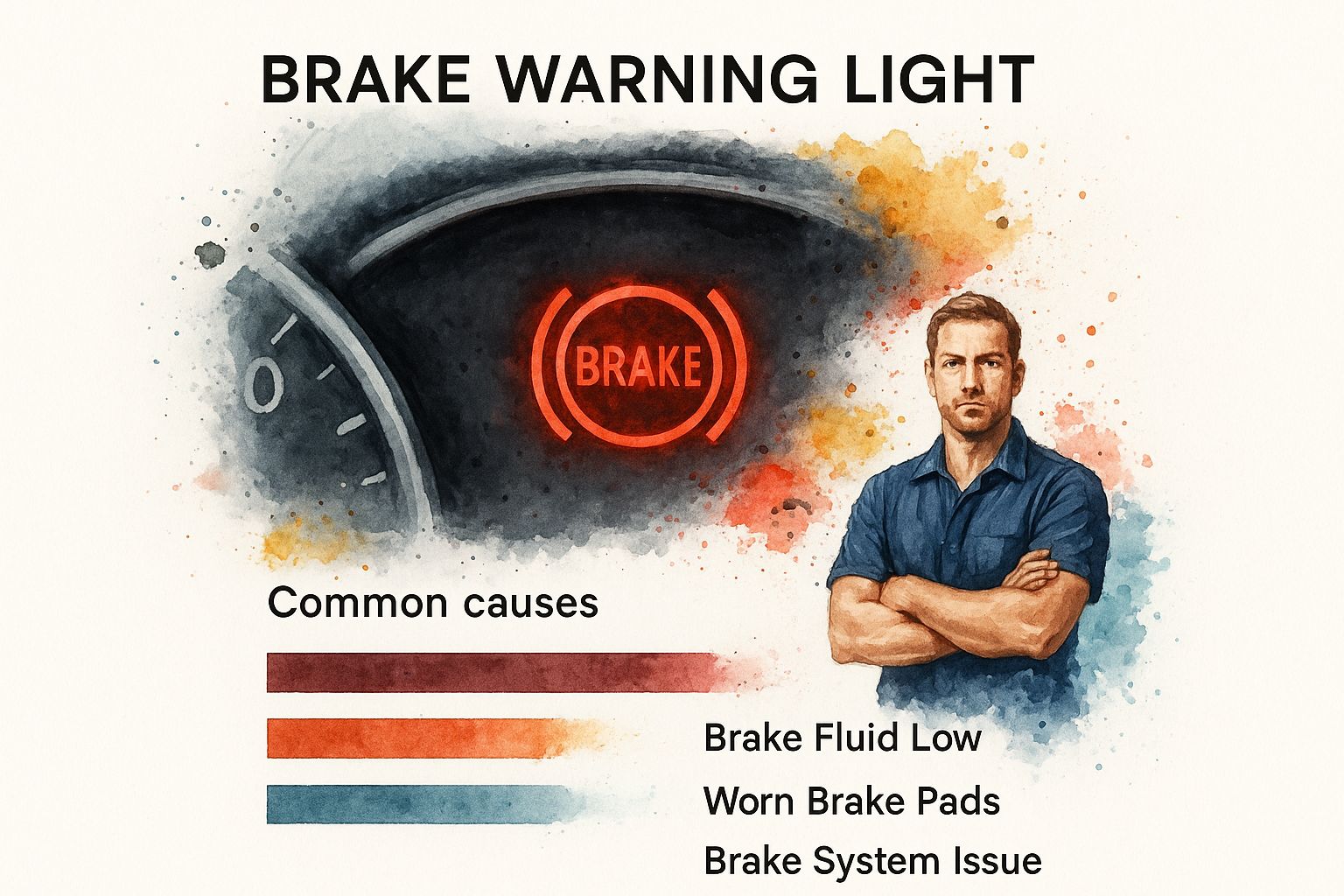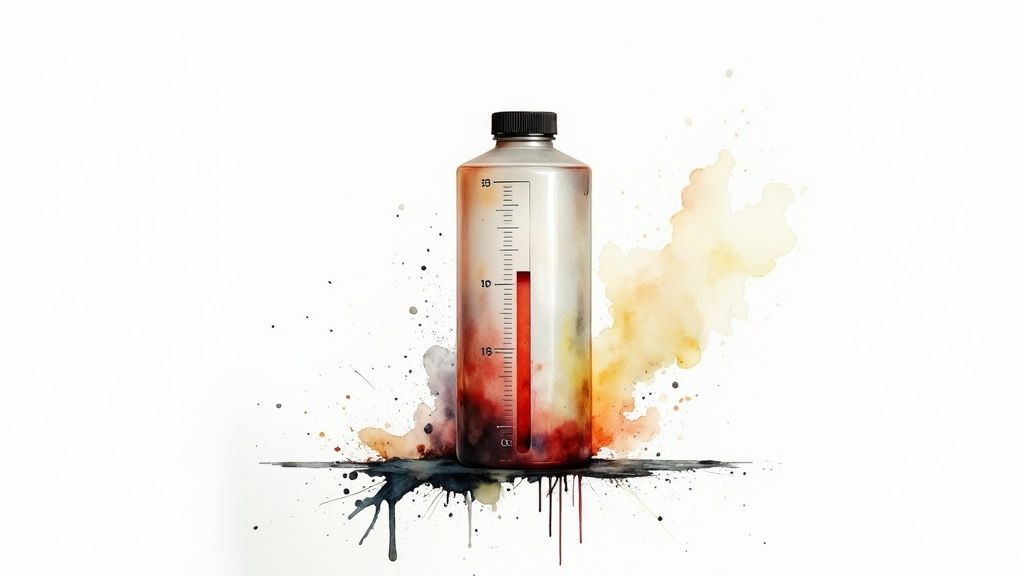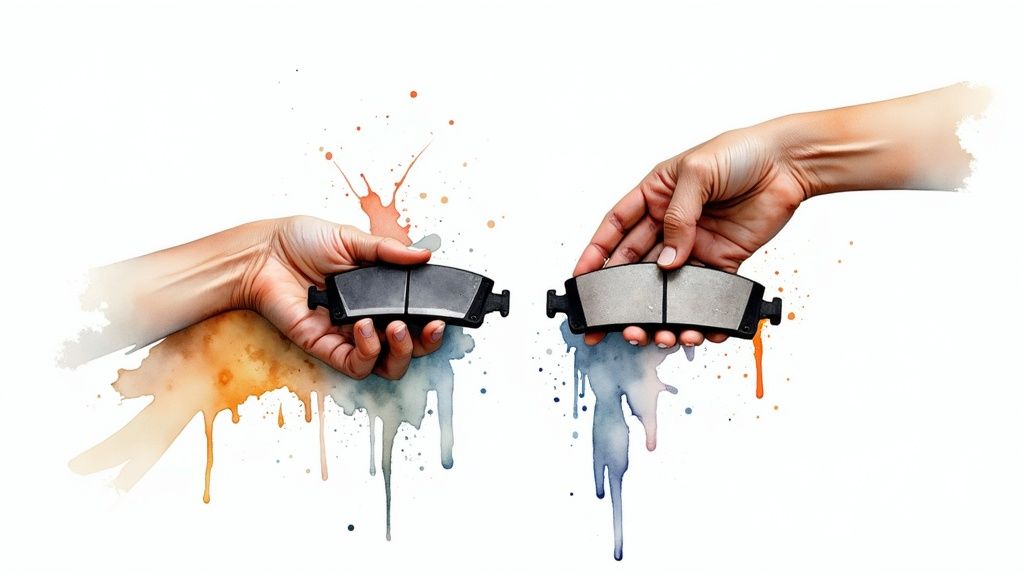Understanding Your Brake Light Warning System
When your dashboard displays a red or amber brake light, your vehicle is communicating a crucial message about the health of your braking system. This warning goes beyond just the lights on the rear of your car. The dashboard brake light indicates the overall condition and performance of your entire braking system. This system is designed to identify potential problems early, allowing you time to address them before they escalate into major safety concerns. Understanding this warning light is the first step in maintaining control and preventing accidents.
Deciphering the Dashboard Symbols
Your dashboard brake light can appear in several forms. It might be the word "BRAKE," an exclamation point inside a circle, or a "P" indicating a parking brake issue. You might also encounter an ABS (Anti-lock Braking System) light. Each symbol corresponds to a different part of your braking system. Recognizing the specific warning is essential for accurate troubleshooting. For instance, a "P" symbol typically indicates a simple parking brake problem, whereas other symbols might suggest more significant issues. Therefore, simply identifying the correct symbol can help narrow down the potential causes.
Continuous vs. Intermittent Warnings
The way your brake light illuminates provides important clues. A continuously illuminated light usually signals a persistent issue requiring immediate attention. On the other hand, an intermittently flashing light may point to a more subtle electrical or sensor problem. Compare it to a constant headache versus an occasional pang—both warrant attention, but the former demands greater urgency. Keeping a record of when and how the light flashes can greatly assist mechanics in diagnosing these often tricky intermittent issues. This information helps them pinpoint the root of the problem more effectively.
The Importance of Prompt Action
The dashboard brake light is a vital warning system alerting drivers to potential problems within their vehicle's braking system. Although not directly related to the external brake lights, understanding its significance contributes to overall vehicle safety. For example, the U.S. National Highway Traffic Safety Administration (NHTSA) focuses on improving rear lighting systems to mitigate rear-end collisions, which account for approximately 28% of all crashes. Regardless of the specific symbol or illumination pattern, any brake light warning should be addressed promptly. This proactive approach can prevent further damage, minimize repair costs, and, most importantly, ensure your safety on the road. Ignoring a brake warning light is akin to dismissing a fever—the underlying problem won't resolve itself and could worsen.
Understanding your brake light warning system empowers you to prioritize your vehicle's safety. By recognizing the different symbols, interpreting continuous versus intermittent warnings, and acting promptly, you are taking a crucial step towards preventing accidents and maintaining a dependable braking system.
What's Triggering Your Brake Warning Light?
That illuminated brake warning light on your dashboard demands your attention. While it might signal a minor issue, it could also indicate a serious safety concern. Let's explore the most common reasons your brake warning light might turn on.

This infographic highlights a car's dashboard with the brake warning light illuminated, suggesting potential problems like low brake fluid or worn brake pads. It serves as a visual reminder of this signal's importance.
Common Culprits: From Simple to Serious
Sometimes, the simplest explanation is the correct one. An engaged parking brake can trigger the warning light. Disengaging the brake solves this easily. However, other issues require a closer look. For example, low brake fluid can drastically reduce your car's stopping power. This often stems from worn brake pads or leaks in the brake system.
Worn brake pads are another common culprit. As they wear down, they lose their effectiveness in creating the friction needed to stop your vehicle. This can increase stopping distances and potentially damage other brake components. A malfunctioning ABS (Anti-lock Braking System) can also illuminate the warning light. The ABS is crucial for preventing wheel lockup during hard braking, so any issues here compromise safety, especially on slick surfaces.
The following table provides a more detailed overview of the common causes, their severity, and the recommended actions to take.
Common Brake Warning Light Causes
| Issue | Severity Level | Common Symptoms | Recommended Action |
|---|---|---|---|
| Engaged Parking Brake | Low | Illuminated brake light | Disengage parking brake |
| Low Brake Fluid | Medium to High | Illuminated brake light, Soft or spongy brake pedal | Check brake fluid level, inspect for leaks, add fluid if needed, consult a mechanic if the problem persists |
| Worn Brake Pads | Medium to High | Illuminated brake light, Grinding or squealing noises during braking, Reduced braking performance | Replace brake pads |
| Malfunctioning ABS | High | Illuminated brake light, ABS warning light might also be on, Potential issues with braking performance | Consult a mechanic immediately |
This table summarizes the typical issues associated with a brake warning light, ranging from simple fixes like disengaging the parking brake to more complex problems requiring professional attention. Addressing these promptly ensures safe and reliable braking performance.
Recognizing the Warning Signs
Besides the illuminated brake light, other symptoms can help identify the specific problem. A soft or spongy brake pedal often suggests low brake fluid or a leak in the brake system. Grinding or squealing sounds during braking typically indicate worn brake pads.
If your vehicle pulls to one side while braking, this could point to uneven brake pad wear or a problem with the brake calipers or rotors. Any vibration felt through the brake pedal requires immediate attention, as it could signify warped rotors or other serious issues.
When to Seek Professional Help
While some brake light issues have simple DIY solutions, others require a professional's expertise. If you notice significant changes in pedal feel, unusual noises, pulling, or vibration, it's crucial to consult a mechanic. Ignoring these warning signs can lead to costly repairs and compromise your safety. Express Lube & Car Care in Haltom City offers brake service performed by certified technicians to ensure your vehicle's safety and reliability. Don't delay addressing a potential problem.
DIY Diagnosis: Checking Your Brake System
When your brake light illuminates on the dashboard, several preliminary checks can often help you identify the issue before heading to a mechanic. These checks are straightforward and safe, regardless of your mechanical experience. You can gain valuable information before even needing a wrench.
Checking Your Parking Brake and Brake Fluid
Begin by ensuring your parking brake is fully released. This frequently overlooked detail can trigger the warning light. Next, locate the brake fluid reservoir under the hood. It's typically a translucent plastic container.
The brake fluid level should be between the minimum and maximum lines. If the level is low, add the specified brake fluid type, consulting your owner's manual for the correct specifications. However, consistently low brake fluid indicates a leak, which demands professional attention. You may be interested in reading more about brake pad maintenance: How to master your brake pad maintenance.
Inspecting Brake Pads and Checking for Leaks
Take a look at your brake pads through the wheel spokes. Thin brake pads indicate the need for replacement. Also, inspect the area beneath your car for brake fluid leaks. Any fluid signifies a problem and requires immediate professional inspection, as leaks compromise braking effectiveness.
Understanding the warning signs of bad brakes is essential. Familiarize yourself with these indicators to ensure your safety on the road.
Documenting Intermittent Warning Patterns
If the brake light appears intermittently, maintain a detailed log. Record when the light activates, the driving conditions at the time, and any other symptoms. This information helps mechanics diagnose tricky, intermittent issues.
Using Diagnostic Tools
OBD-II scanners offer an affordable way to gain further insight into the brake light issue. These devices connect to your car's diagnostic port and retrieve error codes, pinpointing specific problems within the brake system or Anti-lock Braking System (ABS).
When to Seek Professional Help
While DIY checks offer valuable preliminary information, certain signs call for professional help. These include a significant change in brake pedal feel (excessive softness or sponginess), unusual noises (grinding or squealing), the vehicle pulling to one side while braking, or vibration in the brake pedal. These symptoms suggest more complex issues requiring specialized tools and expertise.
Rear-end collisions pose a significant concern on roads worldwide, particularly for vehicles stopped or moving slowly. The role of brake lights in preventing these accidents remains an area of ongoing research. Studies, like one examining the impact of flashing brake lights, indicate that enhanced visual cues can influence driver response times and traffic flow, potentially decreasing rear-end collisions.
Addressing brake problems promptly safeguards both your safety and the lifespan of your braking system. Never hesitate to seek professional assistance when necessary – it's a wise investment for peace of mind.
When Professional Brake Service Becomes Essential
While some brake light warnings have simple DIY solutions, many require a qualified mechanic's expertise. This section helps you recognize those critical warning signs that demand immediate professional attention. These include significant changes in brake pedal feel (softness or sponginess), grinding or squealing noises, the vehicle pulling to one side during braking, or vibration through the pedal. Understanding these signs is the first step in knowing when to seek professional help.
Identifying Critical Warning Signs
A soft or spongy brake pedal often signals low brake fluid or a leak in the brake system. This decreased responsiveness can severely impact your stopping distance and overall vehicle control. Similarly, grinding or squealing sounds generally indicate worn brake pads. If you experience either of these, don't delay a professional inspection.
If your vehicle pulls to one side when braking, this suggests uneven brake pad wear or a problem with the brake calipers or rotors. This uneven braking force can make it difficult to maintain control, especially in emergencies.
Finally, any vibration felt through the brake pedal requires immediate professional attention. This could be caused by warped rotors, which reduce braking efficiency and can lead to further damage.
Choosing the Right Automotive Professional
Not all automotive professionals specialize in brake systems. Look for mechanics with certifications like ASE (Automotive Service Excellence) certification in brakes. This ensures they possess the necessary training and expertise to diagnose and repair complex brake issues. A qualified mechanic can provide accurate assessments and recommendations tailored to your specific vehicle's needs. Check out our guide on saving on brake service.

What a Comprehensive Brake Inspection Should Include
A thorough brake inspection goes beyond checking the brake pads. It should include an assessment of the entire brake system, including the rotors, calipers, brake lines, hoses, and brake fluid. The mechanic should also check for leaks, measure rotor thickness, and inspect the brake hoses' condition. This comprehensive approach helps identify potential problems before they escalate.
Modern Diagnostic Procedures
Modern vehicles utilize sophisticated electronic brake systems, often requiring specialized diagnostic tools. These tools, like scan tools, can pinpoint hidden issues that traditional methods might miss by retrieving error codes from the vehicle's computer, providing valuable insights into the brake system's electronic components. These advanced diagnostics provide a detailed understanding of your brake system's performance and can identify potential problems early.
Realistic Cost Expectations
The cost of brake repairs varies depending on the issue and the vehicle. Replacing brake pads is generally less expensive than repairing or replacing rotors or calipers. Getting a clear estimate from a reputable mechanic before any work begins is essential. This transparency allows you to understand the repair's scope and make informed decisions.
Addressing brake problems promptly isn't just about vehicle maintenance; it's about safety. By recognizing the critical warning signs and seeking professional help when necessary, you prioritize safety and ensure your vehicle's braking system remains in top condition.
Preventing Future Brake Light Surprises
The best way to avoid a brake light warning is to prevent it in the first place. This involves understanding your braking system and sticking to a proactive maintenance schedule. By taking these steps, you can ensure your brakes are reliable and significantly reduce the chances of unexpected dashboard warnings.
The Importance of Regular Maintenance
Just like any other complex system, your brakes need regular attention to function at their best. This includes routine checks of your brake fluid, brake pads, and other essential components. Think of it as similar to regular dental checkups – preventative care avoids bigger problems down the road.
Different driving styles and environments also impact wear and tear. City driving, with its frequent stop-and-go traffic, puts more strain on your brakes than highway driving. Similarly, driving in mountainous terrain creates more wear than driving on flat surfaces.
Brake Fluid: The Lifeblood of Your Brakes
Brake fluid is hygroscopic, which means it absorbs moisture from the air over time. This absorbed moisture can lower the fluid's boiling point, leading to reduced braking performance and potentially even brake failure.
Therefore, regular brake fluid testing and changes are critical. Most manufacturers recommend replacing brake fluid every two to three years, or as advised in your owner's manual. This ensures the fluid remains effective and protects your system from corrosion.
Inspecting Your Brake Components
Regular visual inspections of your brake components can also help catch potential problems early. Check your brake pads for wear, looking for thin pads that might need replacing.
Also, inspect the brake lines and hoses for any signs of leaks or damage. These quick checks can stop small issues from becoming major repairs.
The Connection Between Tires and Brakes
Your tires play a vital role in brake performance. Worn or improperly inflated tires can increase stopping distances and put added stress on your braking system.
Maintaining the correct tire pressure and replacing worn tires when necessary contributes to optimal braking and prolongs the life of your brake components.
Modern vs. Older Brake Systems
Modern vehicles often include electronic brake systems like ABS (Anti-lock Braking System) and Electronic Stability Control (ESC). These systems have different maintenance requirements than older, mechanical systems.
Consulting your owner's manual or a qualified mechanic for specific recommendations for your vehicle’s electronic brake system is crucial. For assistance, Kwik Kar offers full auto repair services, including brakes.
Driving Habits and Brake Longevity
Your driving habits significantly affect your brakes’ lifespan. Aggressive driving, with hard braking and acceleration, puts a lot more stress on your brakes than smooth, controlled driving.
By driving more gently, you can extend the life of your brakes and reduce the need for early replacements. This not only saves you money but also contributes to a safer driving experience.
The following table outlines a recommended brake system maintenance schedule. It provides a helpful overview of key tasks, recommended intervals, warning signs, and approximate costs. Understanding these guidelines will assist you in proactively maintaining your vehicle's braking system.
Brake System Maintenance Schedule
| Maintenance Task | Recommended Interval | Warning Signs if Overdue | Approximate Cost |
|---|---|---|---|
| Brake Pad Inspection | Every 12,000 miles | Squealing or grinding noise, reduced braking effectiveness | Varies based on vehicle type |
| Brake Pad Replacement | Every 25,000-70,000 miles (depending on driving habits and pad material) | Squealing or grinding noise, vibration when braking, brake pedal feels soft | $150-$400 per axle |
| Brake Rotor Inspection/Resurfacing or Replacement | Every 50,000-70,000 miles | Vibration when braking, pulsating brake pedal | $100-$300 per rotor |
| Brake Fluid Flush | Every 2-3 years or as recommended by manufacturer | Soft or spongy brake pedal, reduced braking performance | $75-$150 |
| Brake Line Inspection | Every year | Visible leaks, cracks, or damage | Varies depending on the extent of damage |
| ABS System Check | Every year | ABS warning light illuminated | Varies depending on the specific issue |
Keeping up with these maintenance tasks can help prevent more costly repairs down the line. Regular maintenance not only ensures your safety but also keeps your vehicle performing at its best.
For example, the use of enhanced brake lights, with features like flashing and increased brightness, has been studied for its safety potential. A study by the NHTSA found that approximately 81% of rear-end collisions involved lead vehicles stopped on the road, suggesting possible benefits from enhanced brake light signals.
By using these preventative strategies, you can significantly reduce the chances of seeing that brake warning light on your dashboard. Regular maintenance, good driving habits, and a proactive approach to brake care are essential for a safer and more reliable driving experience.
Dashboard Warnings vs. External Brake Lights

Your vehicle's safety relies on two key components: the dashboard brake warning light and the external brake lights. While both relate to braking, they have distinct roles. This section explains how these systems work together, their differences, and the importance of maintaining them.
Understanding the Separate Systems
External brake lights are simple. They activate when the brake pedal is pressed, alerting drivers behind you. The dashboard brake light is more nuanced. It monitors the entire braking system, including the parking brake, brake fluid, brake pads, and the ABS system. It illuminates when a potential problem is detected. The dashboard light is an early warning system, while external lights primarily communicate with other drivers.
How Electrical Issues Can Affect Both Systems
Electrical problems can impact both the dashboard warning and external brake lights. A faulty brake light switch can prevent the rear lights from activating and simultaneously trigger the dashboard light. Similarly, a blown fuse or wiring issue can disrupt power to both. Addressing any electrical problems promptly is crucial to ensure both sets of lights work correctly.
Dashboard Warnings as Precursors to External Light Failures
The dashboard brake light can sometimes predict external brake light failure. Low brake fluid, indicated by the dashboard light, can eventually lead to brake light failure. If the fluid level drops too low, the hydraulic system, responsible for activating the lights, may fail. Addressing dashboard warnings immediately is vital, as they can indicate issues affecting communication with other drivers.
Separate Circuits and Differentiating Issues
While interconnected, the dashboard brake warning light and external lights often have separate electrical circuits. This means one can malfunction while the other functions normally. Worn brake pads might trigger the dashboard light, while the external lights work perfectly. This separation allows for more precise troubleshooting. If only the dashboard light is on, the problem likely lies within the braking system. If both are affected, the issue might be electrical. Check out our guide on vehicle lights for more information.
Safety Implications of System Failures
Failures in either system have significant safety implications. Malfunctioning external brake lights increase the risk of rear-end collisions, especially in low visibility. A faulty dashboard brake light can hide serious braking system problems, leading to reduced stopping power. Ensuring both systems work correctly is crucial for your safety and the safety of others.
For all your brake service and maintenance needs, trust the experts at Express Lube and Car Care. We offer comprehensive brake inspections, repairs, and maintenance services.





